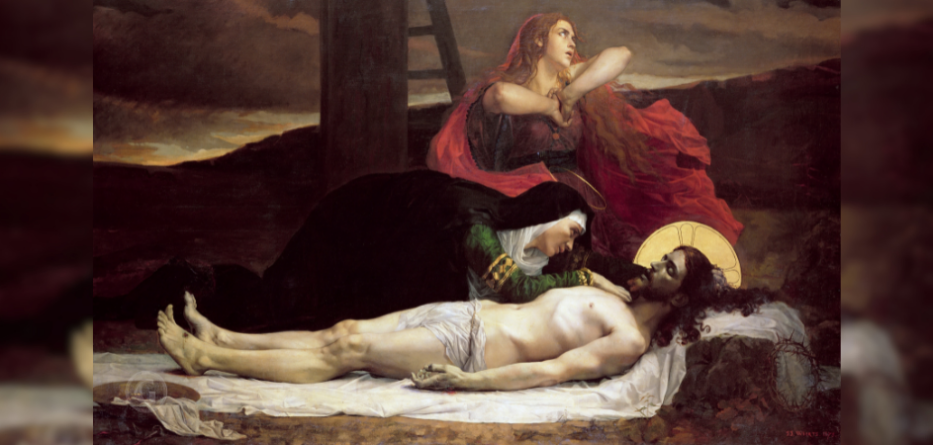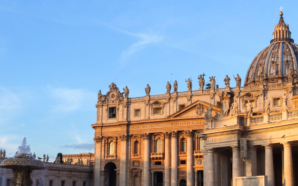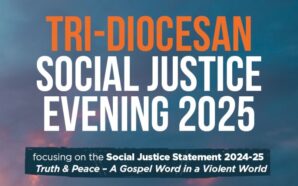Palm Sunday
Readings: LUKE 19:28–40, ISAIAH 50:4–7, PSALM 21(22):8–9, 17–20, 23–24, PHILIPPIANS 2:6–11, LUKE 22:14–23:56
13 April 2025
Gospel Reflection: Be the donkey
Throughout Lent, we’ve stayed close to Jesus. We’ve tried to pray more, to live in his presence, and to imagine ourselves in the Gospel scenes we’ve read. We’ve made sacrifices and offered penance, but inconsistently and halfheartedly. The measure of a good Lent is getting to know ourselves better and recognising our weakness. Our failures this Lent serve us well. They keep us humble. We need Jesus.
At the start of Lent, we watched Jesus scorn the worldly honours Satan offered him. Throughout his public ministry, he always avoided praise. When crowds tried to acclaim him king, he hid from them. But today is different. Now that he is about to die, he allows himself to be led in triumph: “Blessed is the King who comes in the name of the Lord!” (Lk 19:38). Jesus knows that he is a King whose throne will be rough timber; his crown will be thorns; three nails his jewels; his chalice full of vinegar.
In one of his finest sermons, St Bernard of Clairvaux compares Palm Sunday and Good Friday: today the crowd calls him King; soon they’ll have no king but Caesar. Green branches are exchanged for the wood of the Cross.
Flowers are exchanged for thorns. Today they spread their garments on the road; soon Jesus is stripped of his own. The fleeting triumph of the Master’s entry into Jerusalem is a lesson for us. St Bernard asks how anyone could have confidence in earthly glory? It is right and just to praise the Lord, but it soon gives way to humiliation and contempt—in the same city, by the same people, in such a short space of time!
We are not made for this world. We will never find complete happiness on earth. We are made for eternity. The capricious crowds in today’s Gospel teach us one lesson; the humble colt teaches us another. When we imagine ourselves accompanying Jesus and the apostles on Palm Sunday, St Josemaría Escrivá recommends we identify with the donkey. He is the closest to Jesus, and he serves the Master well. A colt is energetic and responsive, lowmaintenance and reliable. A good role model.
Sooner or later, rightly or wrongly, we each receive credit and enjoy special treatment. We are filled with a sense of importance. We relish the feeling, and we look around, acknowledging people’s praise, eager for more. But if we identify with the donkey, we will detach ourselves from the acclaim and red-carpet treatment. If our head swells and pride blinds us, we will crash against some obstacle in the middle of the road. Sometimes metanoia requires humiliation. Jesus intervenes. He corrects our path; we bow our head low and fix our eyes ahead. No more frivolous thoughts or wandering gazes. The cheers around us aren’t for us; they belong to God.
Jesus is a kind master, and it’s a joy to serve him. His yoke is easy, and his burden light. When we are close to him, we experience his peace. He lets us amble along at a pace of our choosing, though he directs the way. He is leading us to the Cross. The Cross is naturally repugnant—not just to us, but to Jesus also. But it’s easier to embrace the Cross when we love the One nailed to it. We are the Lord’s donkey this Holy Week. We accompany Jesus at every step, and our goal is to love more.
Fr John Corrigan
Spiritual Direction: He keeps us company
ome of us believe that once our hearts change, everything will fall into place—no more suffering, pain, or hardship. While life may become more bearable, it will unfold as God wills, not as we expect. This road of metanoia is not a passport to a life of ease, it is a passport to peace, and there will always be a price.
I read a transcript of an interview with an African American worker who was very involved in the civil rights movement with Dr Martin Luther King Jr. He had suffered all the degradation and deprivation imaginable. His family had been targeted, and he had been arrested and tortured. His body bore the scars. He was a big man and gave as good as he got. His bitterness drove him to inflict as much harm on his enemies as possible, in countless ways. He would often say, with complete justification, that his hatred consumed him. The journalist interviewing him made the observation that during his latest arrests, he had not been like that, something was different. The civil rights worker replied that he had experienced a moment of profound realisation. He saw that when he lashed out, he was only furthering the path of hatred, anger and bitterness. It seemed to worsen within him, and it spread like electricity making its home in someone else. The hatred grew more toxic.
So, he chose to let the hatred die within him, allowing his body to absorb it rather than release it back into the world. He said that he now saw his job as becoming a “graveyard for hate”. It seems to me that when we become a graveyard for hate, we also become a cave of resurrection for peace, kindness, goodness, and all that reflects God’s nature.
When Jesus endured all that he did, he was, in fact, telling us that in our Gethsemanes— our betrayals, rejections, failures, pain, and whatever else— we are not alone.
This is actually what Jesus did in his own passion and death—he became a graveyard for hate. It was a free decision on his part; the Father did not force him into it. And Jesus, like the civil rights worker, did not leave a trail of bitterness, anger, and retribution behind him—only forgiveness. It is our big reason for celebration. This is our salvation.
Let’s return to our reflection from the first week, when we talked about keeping God company. Jesus walked into this world claiming all the hatred that was not his, and he became its graveyard. Then he invited us to keep him company, as he did the civil rights worker. If there has been a movement of the Spirit in you that says, “I want to be a graveyard like this, too,” then these days of Lent have worked a change of heart—there has been a metanoia. It means that the peace the world cannot seem to access right now will become a reality, and in the words of the wonderful song, Dream Lady, by Fr Kevin Bates SM, Jesus will “not have wasted his time, walking round Galilee”.
One more thing: when Jesus endured all that he did, he was, in fact, telling us that in our Gethsemanes—our betrayals, rejections, failures, pain, and whatever else—we are not alone. He went there first to keep us company, and it is he who guarantees our resurrection. It may look different for each of us, but it is real all the same.
Remember, paraphrasing the words of Julian of Norwich, “God did not promise that there would be no suffering. He promised that you would not be overcome by it.”
Mother Hilda Scott OSB
Artist Spotlight
The Descent of Christ from the Cross (1875) Jean Joseph Weerts (1847-1927) Oil on Canvas, 180cm x 290cm. Museum of Art and Industry (La Piscine, Musee d’Art et d’Industrie), Roubaix, France. Public Domain.
Born on 1 May 1847 in Roubaix, a town in Northern France, Jean Joseph Weerts came from a family of Belgian heritage. Showing an interest in art from an early age, he moved to Paris to begin professional studies at the prestigious École des Beaux-Arts. He gained recognition for his historical and religious works, distinguished by their meticulous detail. Additionally, he was a masterful portrait artist, adept at capturing the likeness of prominent figures with remarkable skill and sensitivity.
Look at his The Descent of Christ from the Cross (1875) which has remained in his hometown. He has used light and darkness to great effect, highlighting the three characters. The white shroud, mentioned by St Luke in today’s Gospel, is a symbol of purity and sacrifice, and greatly contrasts Our Lady’s black veil representing the depth of her sorrow. Yet, her face is not filled with grief “like those who have no hope” (1 Th 4:13). Rather, she exhibits profound motherly compassion. “All you who pass this way, look and see: is any sorry like the sorrow inflicted on me?” (Lm 1:12). And like his mother’s, Christ’s face shows a calm dignity, even in death.
But not Mary Magdalen. Her red garments tell us of the agony of grief she’s undergoing, a grief which will only be soothed by Christ’s appearance to her on Easter Sunday.
In the background is the Cross silhouetted against the darkened sky, reflecting the sorrow and chaos of the moment. Remember that Jerusalem had witnessed a total eclipse of the sun that day, and an earthquake. Even nature was in revolt at mankind’s rejection of its Saviour. Gently resting near Jesus’ head is the crown of thorns—symbol of mockery.
In this painting, Weerts has achieved what he set out to do—the whole scene must move the viewer to deeply reflect on what has happened. “He honoured (us) by being dishonoured; he gave (us) life by being put to death” (St Augustine, Sermon 171).
Monsignor Graham Schmitzer
Fr John Corrigan is an assistant priest in the Diocese of Ballarat. He currently ministers in the parish of Sunraysia, centred on Mildura in the far north of Victoria, although he is also known in other parts for his “Blog of a Country Priest,” and for regular appearances on Network Ten and Foxtel’s Mass For You At Home.
Mother Hilda Scott OSB is the former abbess of the Benedictine Sisters at Jamberoo Abbey, NSW. Before becoming abbess, she served as prioress, novice mistress, and vocation director, and engaged in spiritual direction, retreat giving, and talks at the Abbey Retreat Cottages. She gained wider recognition through the ABC TV documentary, The Abbey. Before 1990, she was in a different religious order, teaching, working with youth and children, and doing pastoral work in parishes. Just before joining Jamberoo, she lived in a caravan park among the most disadvantaged in society.
Monsignor Graham Schmitzer is the retired parish priest of Immaculate Conception Parish in Unanderra, NSW. He was ordained in 1969 and has served in many parishes in the Diocese of Wollongong. He was also chancellor and secretary to Bishop William Murray for 13 years. He grew up in Port Macquarie and was educated by the Sisters of St Joseph of Lochinvar. For two years he worked for the Department of Attorney General and Justice before entering St Columba’s College, Springwood, in 1962. Mgr Graham loves travelling and has visited many of the major art galleries in Europe.
With thanks to the Diocese of Wollongong, who have supplied this reflection from their publication, METANOIA – Lenten Program 2025. Reproduced with permission.








